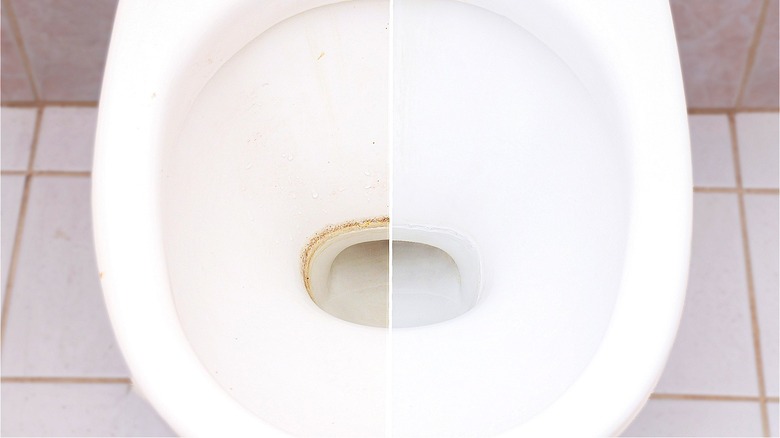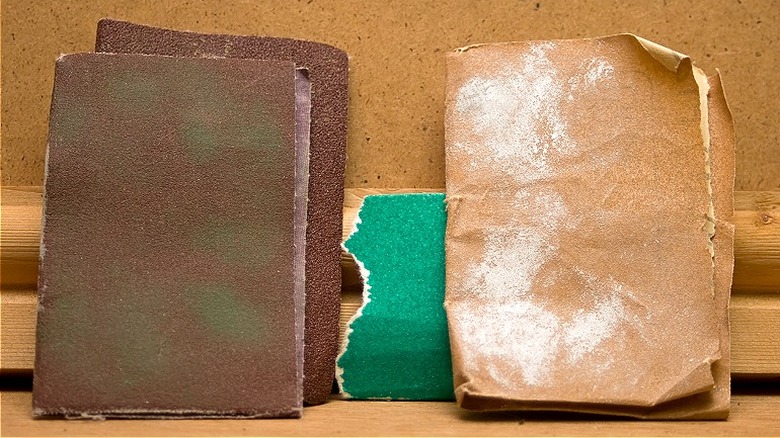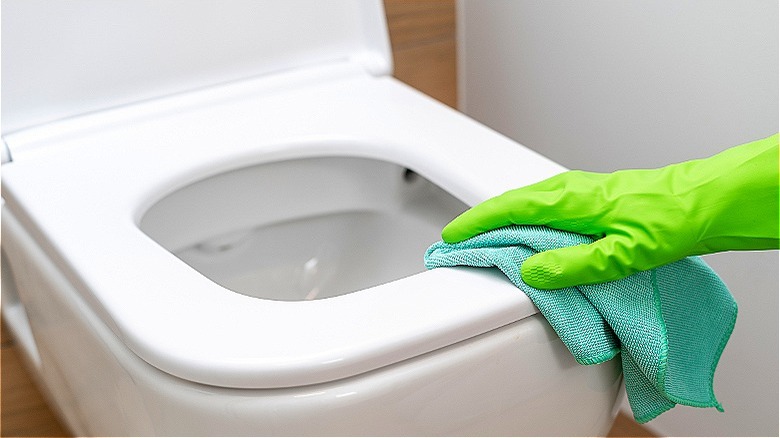The Unlikely Item To Bring Life Back To Your Badly Stained Toilet
So you have an irreparably stained toilet seat (or what seems to be). All of the cleaning solutions, from eco-friendly green cleaners to heavy-duty foaming cleansers, just don't seem to penetrate those stains. That's likely because those stains are actually mineral stains in hard water. These can range from green to brown to red and aren't the normal type of stains that occur from regular use. Just like the limescale that builds up in your shower, minerals like calcium, magnesium, and iron create buildup in toilet systems, and if left to sit, can be really difficult to remove and can cause hard water horrors. However, there may be one unlikely solution that can bring back the shine to that stained toilet bowl: sandpaper.
Yes, if you feel like you've thrown everything you can at your mineral-stained toilet bowl, you may want to give sandpaper a try. Sandpaper probably doesn't immediately come to mind as a cleaning product, but its grit and abrasive qualities make it great at breaking down hardened mineral deposits, and it's affordable with no harsh chemicals, too.
Sandpaper may save your toilet's day
Before you get started with the sandpaper, be sure to give your stained toilet bowl a good cleaning to remove any fecal matter or bacterial growth. This hack is very hands-on, so you want to be sure you're working in a clean environment. We also recommend using rubber gloves that can be sanitized or disposed of after wearing to protect against germs and potential injury from the sandpaper.
You don't want to use just any sandpaper for a task like this. Make sure you find some with extra-fine grit, or 320 to 360 grit. As many toilet bowls are covered in ceramic or plastic, you want to take care not to rub so hard that you actually break down the surface (for reasons we'll come back to).
It should also be wet during cleaning. In addition to using at least extra-fine sandpaper, you want to work slowly, and precisely. If you come in and scrape away with reckless abandon, you have a greater chance of bringing the sandpaper in direct contact with the surface, which can cause damage.
While you slowly work away at the mineral buildup with sandpaper in hand, try to work in sections. If you're having a difficult time gauging progress as you scrape, rinse the toilet bowl frequently while sandpapering. That way, you have a better idea of which areas still need more help when excess mineral and sandpaper residue is washed away.
Exhaust your other options first
Even though sandpaper is a cheap, relatively simple solution for reviving your stained toilet bowl, it still shouldn't be your first choice. While sandpaper should effectively break down mineral buildup, it can also be a tedious and, as mentioned, slightly risky option. That's because it's very easy to damage the surface area of the ceramic or plastic bowl with sandpaper.
That might not seem like a huge deal, but even small scratches or dents can become a problem in a toilet bowl. That's largely due to hygiene hazards. The reason toilet bowls are coated in hard, slick coatings is so no bacteria can reside after flushing and regular cleaning, but cracks and scratches create little hiding spots for such bacteria. These can also go on to crack further, leading to leaks and expensive repairs.
If you accidentally scratch your toilet bowl's surface while using the sandpaper method, don't lose hope. You can try to repair scratches in your toilet bowl yourself, but if it's at all extensive, you'll need to call a professional, who will have a better chance at reviving your toilet bowl with the right tools and skill set.


